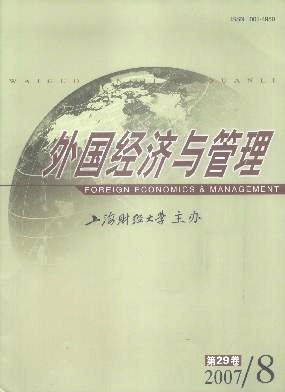国外工作不满意与员工创造性研究进展
外国经济与管理 2007 年 第 29 卷第 08 期, 页码:38 - 44
摘要
参考文献
摘要
近年来,员工工作不满意问题得到了国外学者的广泛关注。相关研究表明,工作不满意对员工创造性产生积极的影响,这方面研究突破了传统组织行为学中有关工作满意度的研究视角,为管理实践提供了有益的指导。本文对相关研究成果进行了梳理和评介,并对国内这一领域的未来研究方向及企业的相关管理实践提出了建议。
[1]Igalens,J,and Roussel,P.A study of the relationships between compensation package,work motivation and job satisfaction[J].Journalof Organizational Behavior,1999,20(7):1 003-1 025.
[2]Wanous,J P,and Youtz,M A.Solution diversity and the quality of group decisions[J].The Academy of Management Journal,1986,29:149-159.
[3]Organ,D W.Job satisfaction and the good soldier:The relationship between affect and employee citizenship[J].The Academy of Man-agement Journal,1983,26:587-595.
[4]Steers,R M,and Rhodes,S R.Major influences on employee attendance:A process model[J].Journal of Applied Psychology,1978,63:391-407.
[5]March,J,and Simon,H.Organizations[M].New York:Wiley,1958.
[6]Lepine,J A,and Van Dyne,L.Predicting voice behaviors in work groups[J].Journal of Applied Psychology,1998,83:853-868.
[7]Farrell,D.Exit,voice,loyalty,and neglect as responses to job dissatisfaction:A multidimensional scaling study[J].The Academy ofManagement Journal,1983,26(4):596-607.
[8]Kaisa Kauppinen-Toropainen,Irja Kandolin,and Pertti Mutanen.Job dissatisfaction and work-related exhaustion in male and femalework[J].Journal of Occupational Behaviour,1983,(3):193-207.
[9]Zhou,J,and George,J M.When job dissatisfaction leads to creativity:Encouraging the expression of voice[J].Academy of Manage-ment Journal,2001,44(4):682.
[10]Withey,M J,and Cooper,W H.Predicting exit,voice,loyalty,and neglect[J].Administrative Science Quarterly,1989,34:521-539.
[11]Woodman,R W,Sawyer,J E,and Griffin,R W.Toward a theory of organizational creativity[J].Academy of Management Review,1993,18:293-321.
[12]Utman,C H.Performance effects of motivational state:A meta-analysis[J].Personality and Social Psychology Review,1997,1:170-182.
[13]Allen,N J,Tett,R P,and Meyer,J P.Job satisfaction,organizational commit ment,turnover intention,and turnover:Path analysisbased on meta-analytic findings[J].Personnel Psychology,1993,46:259-293.
[14]Rusbult,C E,Farrell,D,Rogers,G,and Mainous,A.I mpact of exchange variables on exit,voice,loyalty,and neglect:An integrativemodel of responses to declining job satisfaction[J].Academy of Management Journal,1988,31:599-627.
[15]Kluger,A N,and DeNisi,A.The effects of feedbackinterventions on performance:Historical review,a meta-analysis and a preli mina-ry feedbackintervention theory[J].Psychological Bulletin,1996,119:254-284.
[16]Cummings,A,and Oldham,G R.Enhancing creativity:Managing work contexts for the high potential employee[J].California Man-agement Review,1997,40(1):22-38.
[17]Scott,S G,and Bruce,R A.Determinants of innovative behavior:Apath model of individual innovationinthe workplace[J].Academyof Management Journal,1994,37:580-607.
[18]Frohman,AL.Igniting organizational change frombelow:The power of personal initiative[J].Organizational Dynamics,1997,25(3):39-53.
[19]Kay,P.An act frequency study of exit,voice,loyalty and neglect[R].Unpublished honors thesis,Depart ment of Psychology,Queen’sUniversity,Kingston,Ontario,1989.
[20]Zhou,J.Feedback valence,feedback style,task autonomy,and achievement orientation:Interactive effects on creative performance[J].Journal of Applied Psychology,1998,83:261-276.
[2]Wanous,J P,and Youtz,M A.Solution diversity and the quality of group decisions[J].The Academy of Management Journal,1986,29:149-159.
[3]Organ,D W.Job satisfaction and the good soldier:The relationship between affect and employee citizenship[J].The Academy of Man-agement Journal,1983,26:587-595.
[4]Steers,R M,and Rhodes,S R.Major influences on employee attendance:A process model[J].Journal of Applied Psychology,1978,63:391-407.
[5]March,J,and Simon,H.Organizations[M].New York:Wiley,1958.
[6]Lepine,J A,and Van Dyne,L.Predicting voice behaviors in work groups[J].Journal of Applied Psychology,1998,83:853-868.
[7]Farrell,D.Exit,voice,loyalty,and neglect as responses to job dissatisfaction:A multidimensional scaling study[J].The Academy ofManagement Journal,1983,26(4):596-607.
[8]Kaisa Kauppinen-Toropainen,Irja Kandolin,and Pertti Mutanen.Job dissatisfaction and work-related exhaustion in male and femalework[J].Journal of Occupational Behaviour,1983,(3):193-207.
[9]Zhou,J,and George,J M.When job dissatisfaction leads to creativity:Encouraging the expression of voice[J].Academy of Manage-ment Journal,2001,44(4):682.
[10]Withey,M J,and Cooper,W H.Predicting exit,voice,loyalty,and neglect[J].Administrative Science Quarterly,1989,34:521-539.
[11]Woodman,R W,Sawyer,J E,and Griffin,R W.Toward a theory of organizational creativity[J].Academy of Management Review,1993,18:293-321.
[12]Utman,C H.Performance effects of motivational state:A meta-analysis[J].Personality and Social Psychology Review,1997,1:170-182.
[13]Allen,N J,Tett,R P,and Meyer,J P.Job satisfaction,organizational commit ment,turnover intention,and turnover:Path analysisbased on meta-analytic findings[J].Personnel Psychology,1993,46:259-293.
[14]Rusbult,C E,Farrell,D,Rogers,G,and Mainous,A.I mpact of exchange variables on exit,voice,loyalty,and neglect:An integrativemodel of responses to declining job satisfaction[J].Academy of Management Journal,1988,31:599-627.
[15]Kluger,A N,and DeNisi,A.The effects of feedbackinterventions on performance:Historical review,a meta-analysis and a preli mina-ry feedbackintervention theory[J].Psychological Bulletin,1996,119:254-284.
[16]Cummings,A,and Oldham,G R.Enhancing creativity:Managing work contexts for the high potential employee[J].California Man-agement Review,1997,40(1):22-38.
[17]Scott,S G,and Bruce,R A.Determinants of innovative behavior:Apath model of individual innovationinthe workplace[J].Academyof Management Journal,1994,37:580-607.
[18]Frohman,AL.Igniting organizational change frombelow:The power of personal initiative[J].Organizational Dynamics,1997,25(3):39-53.
[19]Kay,P.An act frequency study of exit,voice,loyalty and neglect[R].Unpublished honors thesis,Depart ment of Psychology,Queen’sUniversity,Kingston,Ontario,1989.
[20]Zhou,J.Feedback valence,feedback style,task autonomy,and achievement orientation:Interactive effects on creative performance[J].Journal of Applied Psychology,1998,83:261-276.
引用本文
徐尚昆. 国外工作不满意与员工创造性研究进展[J]. 外国经济与管理, 2007, 29(8): 38–44.
导出参考文献,格式为:
上一篇:柔性领导理论评介
下一篇:CEO任期与企业绩效关系模型探讨





 7279
7279  584
584

